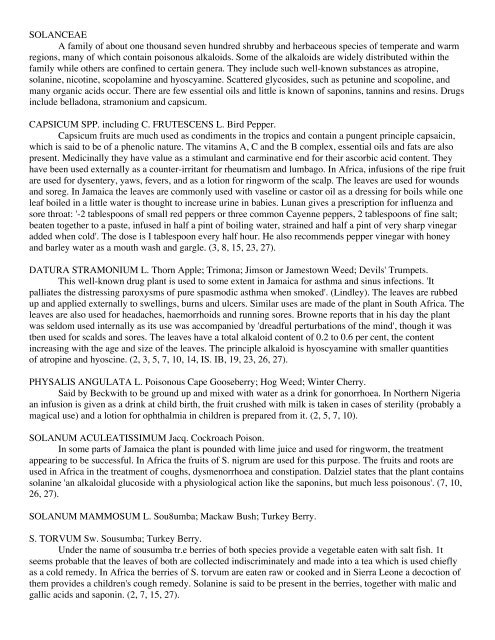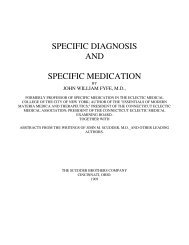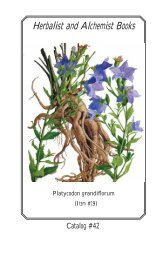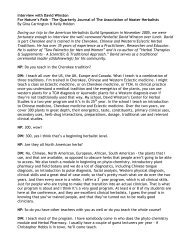MEDlCINAL PLANTS OF JAMAICA. PARTS 1 & 11.
MEDlCINAL PLANTS OF JAMAICA. PARTS 1 & 11.
MEDlCINAL PLANTS OF JAMAICA. PARTS 1 & 11.
You also want an ePaper? Increase the reach of your titles
YUMPU automatically turns print PDFs into web optimized ePapers that Google loves.
SOLANCEAE<br />
A family of about one thousand seven hundred shrubby and herbaceous species of temperate and warm<br />
regions, many of which contain poisonous alkaloids. Some of the alkaloids are widely distributed within the<br />
family while others are confined to certain genera. They include such well-known substances as atropine,<br />
solanine, nicotine, scopolamine and hyoscyamine. Scattered glycosides, such as petunine and scopoline, and<br />
many organic acids occur. There are few essential oils and little is known of saponins, tannins and resins. Drugs<br />
include belladona, stramonium and capsicum.<br />
CAPSICUM SPP. including C. FRUTESCENS L. Bird Pepper.<br />
Capsicum fruits are much used as condiments in the tropics and contain a pungent principle capsaicin,<br />
which is said to be of a phenolic nature. The vitamins A, C and the B complex, essential oils and fats are also<br />
present. Medicinally they have value as a stimulant and carminative end for their ascorbic acid content. They<br />
have been used externally as a counter-irritant for rheumatism and lumbago. In Africa, infusions of the ripe fruit<br />
are used for dysentery, yaws, fevers, and as a lotion for ringworm of the scalp. The leaves are used for wounds<br />
and soreg. In Jamaica the leaves are commonly used with vaseline or castor oil as a dressing for boils while one<br />
leaf boiled in a little water is thought to increase urine in babies. Lunan gives a prescription for influenza and<br />
sore throat: '-2 tablespoons of small red peppers or three common Cayenne peppers, 2 tablespoons of fine salt;<br />
beaten together to a paste, infused in half a pint of boiling water, strained and half a pint of very sharp vinegar<br />
added when cold'. The dose is I tablespoon every half hour. He also recommends pepper vinegar with honey<br />
and barley water as a mouth wash and gargle. (3, 8, 15, 23, 27).<br />
DATURA STRAMONIUM L. Thorn Apple; Trimona; Jimson or Jamestown Weed; Devils' Trumpets.<br />
This well-known drug plant is used to some extent in Jamaica for asthma and sinus infections. 'It<br />
palliates the distressing paroxysms of pure spasmodic asthma when smoked'. (Lindley). The leaves are rubbed<br />
up and applied externally to swellings, burns and ulcers. Similar uses are made of the plant in South Africa. The<br />
leaves are also used for headaches, haemorrhoids and running sores. Browne reports that in his day the plant<br />
was seldom used internally as its use was accompanied by 'dreadful perturbations of the mind', though it was<br />
tben used for scalds and sores. The leaves have a total alkaloid content of 0.2 to 0.6 per cent, the content<br />
increasing with the age and size of the leaves. The principle alkaloid is hyoscyamine with smaller quantities<br />
of atropine and hyoscine. (2, 3, 5, 7, 10, 14, IS. IB, 19, 23, 26, 27).<br />
PHYSALIS ANGULATA L. Poisonous Cape Gooseberry; Hog Weed; Winter Cherry.<br />
Said by Beckwith to be ground up and mixed with water as a drink for gonorrhoea. In Northern Nigeria<br />
an infusion is given as a drink at child birth, the fruit crushed with milk is taken in cases of sterility (probably a<br />
magical use) and a lotion for ophthalmia in children is prepared from it. (2, 5, 7, 10).<br />
SOLANUM ACULEATISSIMUM Jacq. Cockroach Poison.<br />
In some parts of Jamaica the plant is pounded with lime juice and used for ringworm, the treatment<br />
appearing to be successful. In Africa the fruits of S. nigrum are used for this purpose. The fruits and roots are<br />
used in Africa in the treatment of coughs, dysmenorrhoea and constipation. Dalziel states that the plant contains<br />
solanine 'an alkaloidal glucoside with a physiological action like the saponins, but much less poisonous'. (7, 10,<br />
26, 27).<br />
SOLANUM MAMMOSUM L. Sou8umba; Mackaw Bush; Turkey Berry.<br />
S. TORVUM Sw. Sousumba; Turkey Berry.<br />
Under the name of sousumba tr.e berries of both species provide a vegetable eaten with salt fish. 1t<br />
seems probable that the leaves of both are collected indiscriminately and made into a tea which is used chiefly<br />
as a cold remedy. In Africa the berries of S. torvum are eaten raw or cooked and in Sierra Leone a decoction of<br />
them provides a children's cough remedy. Solanine is said to be present in the berries, together with malic and<br />
gallic acids and saponin. (2, 7, 15, 27).







